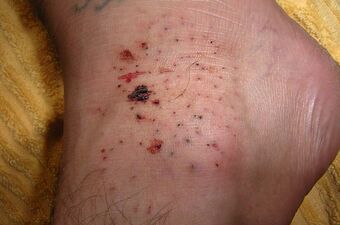Medicine:Sea urchin injury
| Sea urchin injury | |
|---|---|
 | |
| Specialty | Emergency medicine |
| Treatment | Removal of spines, hot water soaks |
Sea urchin injuries are caused by contact with sea urchins, and are characterized by puncture wounds inflicted by the animal's brittle, fragile spines.[1]:431 Injuries usually occur when swimmers, divers, surfers, or fisherpeople accidentally contact a sea urchin with their hands or feet.[2]
Immediate symptoms of sea urchin injuries include pain, bleeding, redness, swelling, and inflammation. Leaving spine fragments in the body may lead to chronic discomfort, tenosynovitis, and arthritis.
Signs and symptoms
Most signs and symptoms of sea urchin injury result from local trauma and inflammatory reactions to spine fragments. They are made of calcium carbonate, making them very brittle and easy to break off in the body.[3]
Symptoms of the initial injury may include pain, bleeding, redness, swelling, and inflammation.[4][1] The injury may show small purple or black dots or staining of the skin from the natural dye inside the sea urchin.[4][1] These symptoms generally subside with complete removal of the spines.[4]
About 80 of the 600 unique species of sea urchins contain poisons, but they generally do not cause significant harm to humans.[5] However, an allergic reaction or large enough dose of the toxins (such as puncture by > 15-20 spines) may lead to systemic effects such as nausea, vomiting, paraesthesia, generalized weakness, and respiratory distress.[4] The most notable species is the flower urchin, which is common in the tropical Indo-West Pacific.[6] There are reports of accidental drowning due to the muscular paralysis, numbness, and disorientation caused by puncture from a flower urchin, but they remain difficult to confirm.[3]
Leaving spine fragments in the body may lead to chronic effects, even if the initial local and systemic symptoms reside. The most common long-term complications include discomfort, tenosynovitis, and arthritis.[1][2][5]
Pathophysiology
Following injury by a non-venomous sea urchin, the spine can stay for a while inside the flesh, causing pain and discomfort. Spines not dissolved or expelled from the body may eventually be surrounded by a granuloma, a normal inflammatory reaction that forms a nodule around foreign bodies.[3][7] Granuloma formation and associated symptoms may not present until several months after the initial injury.[7]
Granulomas that happen to form near or within tendons, joints, or muscles may obstruct normal function of those structures, leading to chronic discomfort, movement deficits, or local inflammation.[8][3] Surgical removal of the spine and granuloma often relieves the symptoms.[8]
Treatment
Embedded spines can often be removed with tweezers with no long-term consequences, but their brittle nature often leaves fragments within the body.[7][9][10] Hot water soaks are thought to destroy toxins, alleviate pain, and help dissolve any remnants of the spines.[7][9][10]
Other common remedies include salicylic acid paste, hot candle wax, vinegar, and urine, but evidence of their benefit remains unclear.[9][10] Small fragments too deep to remove with tweezers are often left alone, as they are known to either extrude through the skin or dissolve over time.[10] Injuries that continue to cause pain or discomfort, show signs of infection, or are associated with nerve or joint injury should be evaluated by a medical professional. X-ray or MRI may be used to visualize deep spines and assess the need for surgical removal.[9][10]
See also
- Bristleworm sting
- List of cutaneous conditions
References
- ↑ Jump up to: 1.0 1.1 1.2 1.3 James, William D. et al. (2006). Andrews' Diseases of the Skin: clinical Dermatology. Saunders Elsevier. ISBN 0-7216-2921-0.
- ↑ Jump up to: 2.0 2.1 Rossetto, André Luiz; Mora, Jamesson de Macedo; Haddad Junior, Vidal (October 2006). "Sea urchin granuloma" (in en). Revista do Instituto de Medicina Tropical de São Paulo 48 (5): 303–306. doi:10.1590/S0036-46652006000500013. ISSN 1678-9946. https://www.scielo.br/j/rimtsp/a/CtffWVyrLtcFMz58TrdjqXM/?lang=en.
- ↑ Jump up to: 3.0 3.1 3.2 3.3 Dahl, William (2010). "Sea Urchin Injuries to the Hand: A Case Report and Review of the Literature". The Iowa Orthopedic Journal 30: 153–156. PMID 21045988.
- ↑ Jump up to: 4.0 4.1 4.2 4.3 Geng, Xiao-Yu (2023-01-27). "Marine biological injuries and their medical management: A narrative review". World Journal of Biological Chemistry 14 (1): 1–12. doi:10.4331/wjbc.v14.i1.1. PMID 36741876.
- ↑ Jump up to: 5.0 5.1 Hsieh, Clifford (November 2016). "Aquatic Antagonists: Cutaneous Sea Urchin Spine Injury". MDedge: Dermatology 98 (5): 303–305. https://www.mdedge.com/dermatology/article/116620/dermatopathology/aquatic-antagonists-cutaneous-sea-urchin-spine-injury.
- ↑ "Toxopneustes pileolus". 2014-11-29. http://www.sealifebase.fisheries.ubc.ca/summary/Toxopneustes-pileolus.html.
- ↑ Jump up to: 7.0 7.1 7.2 7.3 Nassab, R. (August 2005). "The Management of Hand Injuries Caused by Sea Urchin Spines". Journal of Hand Surgery (European Volume) 30 (4): 432–433. doi:10.1016/J.JHSB.2005.04.001. https://journals.sagepub.com/doi/full/10.1016/J.JHSB.2005.04.001.
- ↑ Jump up to: 8.0 8.1 Wada, Takuro (March 2008). "Sea Urchin Spine Arthritis of the Hand". The Journal of Hand Surgery 33 (3): 398–401. https://www.sciencedirect.com/science/article/pii/S0363502307010386.
- ↑ Jump up to: 9.0 9.1 9.2 9.3 Schwartz, Ziv (2021). "Sea urchin injuries: a review and clinical approach algorithm". Journal of Dermatological Treatment 32 (2): 150–156. doi:10.1080/09546634.2019.1638884. https://www.tandfonline.com/doi/abs/10.1080/09546634.2019.1638884.
- ↑ Jump up to: 10.0 10.1 10.2 10.3 10.4 Thomas, Scott, Craig, Susan (1997). All Stings Considered. University of Hawai'i Press. pp. 76–80. ISBN 0824819004.

